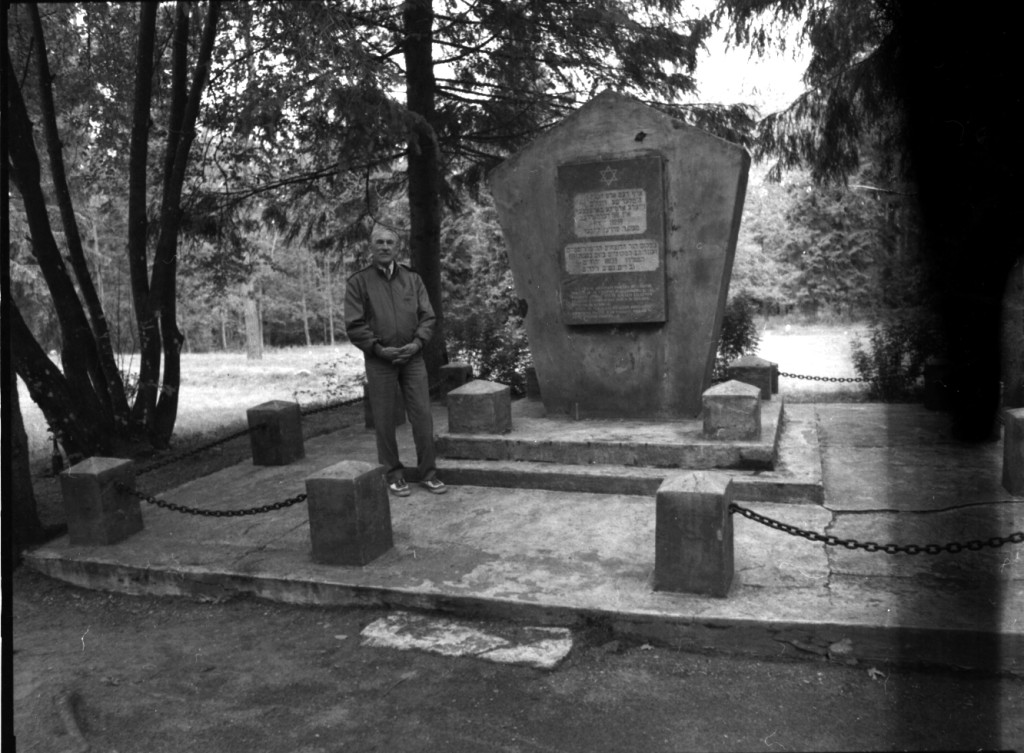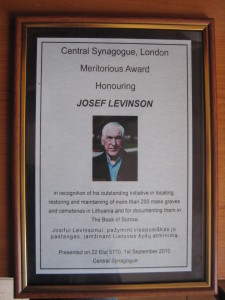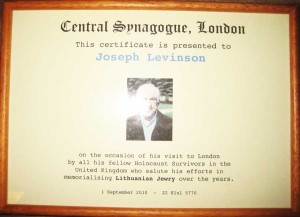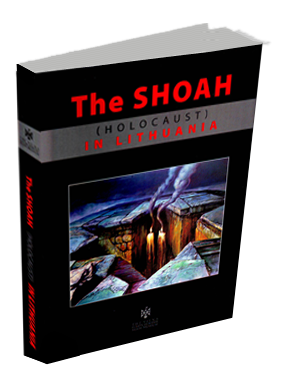Over half a century has passed since the Nazi occupation, which was so horrendous to the Jews of Lithuania. Because of Soviet policy in regard to the Jews, however, the generation that grew up in Lithuania during the postwar years knows essentially nothing about the Catastrophe that befell Lithuanian Jews during World War II. It should be noted that the topic of the Shoah[1] (Holocaust) was taboo for more than half a century during Soviet times (memorial plaques in the places where Jews had been massacred had inscriptions that “Soviet people” or “Soviet citizens” had been killed there).
Yet the whole truth about the Shoah in Lithuania should, it seems, be known to all the people of Lithuania. After all, this is a tragic page in Lithuanian history and a huge moral problem — all the more so because, until now, the events connected with it have often been willfully distorted and thus the development of normal relations between Lithuanians and Jews has been hindered.
Therefore, it is important to create an opportunity for the people of Lithuania to become acquainted with the Tragedy that befell Lithuanian Jews during the Hitlerite occupation — a Tragedy in which a centuries-old community, after participating in the battles for independence after World War I and helping strengthen the Lithuanian state and develop the economy, was (essentially in half a year, once war between Germany and Russia had begun) brutally destroyed.
With the beginning of Sąjūdis, the movement for national rebirth, Lithuanians also began to discuss, publicly and freely, what they had endured after their country had lost its independence. At that time, understandably, the grisly Tragedy that befell the Jews of Lithuania could not fail to emerge as well. The atmosphere of tolerance, goodwill, and compassion that then prevailed in Lithuania gave hope that the Catastrophe suffered by Lithuanian Jews would finally also be evaluated honestly and unequivocally. However, this hope slowly began to fade. Voices were heard, and forces appeared, that through the news media — the press, radio, and television — began attacking the Jews, at times causing an ugly anti-Semitic hysteria during which, along with the repetition of anti-Jewish myths that are no longer popular in the democratic world, there arose the so-called theory of the two genocides: a theory whose purpose was essentially to exonerate those Lithuanians who had helped the Nazis perpetrate a total massacre of the Jews — starting with newborn infants and ending with feeble old people — regardless of their political or religious convictions, their social status, origin, or activities. And this exoneration is still being attempted today, at a time when capital punishment is being abolished in the democratic world — and has already been in Lithuania — even for the most serious crimes.
Thus, today we encounter the so-called phenomenon of anti-Semitism without Jews, for by 1995 only about 5,000 Jews remained in Lithuania, and at present there are even fewer of them, and most of the people in present-day Lithuania have, most likely, never even seen a Jew with their own eyes (after all, except for the big cities of the Republic, almost nowhere will you find a single Jew). And in the economic and political life of Lithuania, Jews do not occupy any even somewhat more significant positions, and there is no real basis for any conflict of interests or competition of the sort that during the interwar years, especially the last one, had encouraged an often aggressive anti-Semitism in Lithuania.
What helped the theory of the two genocides flourish was that, for a considerable time after independence had been re-established, little could be found in the history textbooks used in schools about the Shoah in Lithuania. And the topic itself was taught in a very roundabout way without making clear the essence of the Shoah.
After the international Holocaust Forum in Stockholm in 2000, the newspaper Lietuvos rytas wrote:
“The Government could probably be more energetic in following the example of Sweden and introduce as quickly as possible new educational programs in which great attention is devoted to the subject of the Jewish genocide. This is no less relevant for Lithuania than for Sweden, where the educational level of society caused great concern when it was learned that as many as 72% of that country’s teenagers did not know the meaning of the word ‘Holocaust.’ After all, in our country, during the entrance exams for Vilnius University, one may hear even from future students that the Holocaust is some poet.”
Prof. Liudas Truska has also emphasized this thought in one of his articles. He has indicated that the most important reason for the persistence of myths and stereotypes, especially in the consciousness of younger people, is ignorance. That is why it is necessary to make knowledge of history more popular.
In “Kas išžudė Lietuvos žydus?” [Who Killed the Jews of Lithuania?] (Akiračiai, 1998, no. 4), which is a review of the book Kollaboration und Massenmord: Die litauische Hilfspolizei, das Rollkommando Hamann und die Ermordung der litauischen Juden, by the young German historian Knut Stang, Prof. Saulius Sužiedėlis writes:
“In Lithuania, the theme of the Jewish genocide is still a painful wound… Often enough, dialog about the Holocaust provokes irrational reactions that sometimes even reek with hatred. […] It is no secret that part of Lithuanian society remains allergic to Holocaust research… The theme of the Holocaust should interest every Lithuanian if only because the massacres during the summer of 1941 were a unique catastrophe in our history: never in the history of Lithuania have so many people been killed in such a short time and in such a systematic manner. Is it not finally time for us also to openly delve into those bloody pages of history, renouncing self-righteous arguments that invoke the theory of the two genocides (“Jews killed us, so we took revenge”) as well as other attempts to avert our gaze from the unpleasant facts of the past?”
After the international Holocaust Forum held in Stockholm, both the world and Lithuania became more active in their reflections about — and in their political and moral assessment of — the events of the Holocaust (Shoah). Notable are the honest, analytical articles about the Shoah in Lithuania published by the émigré monthly Akiračiai in the United States. For all practical purposes, however, this literature is not accessible to the mass of readers. In addition, there is a lack of popular literature on these questions.
The news media are slow to change their orientation. From time to time, one or another publisher or television channel will publicize scandalous material with anti-Semitic content.
***
Once the war between Hitlerite Germany and the Soviet Union had begun, the Nazis rushed with all their might to perpetrate the Holocaust as a state program. In those days, the cities and towns of Lithuania were enveloped by an atmosphere threatening to Jews. At once, the Jews lost the protection of the law. The Nazis and their local collaborators, who were incited by the propaganda of the Lithuanian Activist Front (LAF), took drastic measures to break the Jews morally and physically so that, ultimately, they could more quickly dispose of them.
Although Lithuanian Jews had heard a great deal about the vicious anti-Jewish campaigns of the Nazis, most of them could not believe that the German nation, which had given the world Goethe, Kant, and Beethoven, would tolerate the destruction of human beings, of an entire people. The Jews did not believe that from among the Lithuanians, with whom they had lived for many centuries, there would appear so many who would raise their hand against their neighbors, and only because they were Jews. Thus, when the war began, only a small number of the Jews withdrew from Lithuania, also partly because their way was often blocked by the White Armbands (baltaraiščiai, i.e. participants in the Lithuanian uprising against the Soviets). Suddenly trapped, the Jews found themselves in the clutches of the powerful terror and destruction machine of the Nazis and their local collaborators. The persecution of the Jews and the plundering of their property began immediately. The Jews were closed up in ghettos. Sadistic torture, starvation, the cynical undermining of human dignity, the rape of women, unbearable work while constantly awaiting death — that was the fate of ghetto inmates. Marched to mass grave pits through violence and trickery, cut down by bullets, hundreds, thousands fell. They were often still alive when they were covered with soil. For the victims of this violence, death often became a kind of salvation because it meant the end of horrifying, unimaginable cruelty and suffering.
Less than half a year after the beginning of the Hitlerite occupation, there were no Jews left in Lithuania except for those whom the Nazis left alive to work in the ghettos of Vilnius, Kaunas, Šiauliai, and Švenčionys. However, their fate is well known. Of nearly a quarter of a million Lithuanian Jews, some 6% survived — those whom the Nazis and their local collaborators were unable to reach or did not manage to kill.
As Commanding Officer of Einsatzkommando 3 of the Security Police and Security Service, Karl Jäger was the executioner-in-chief of the Jews of Lithuania. In his report to Berlin, “Comprehensive Statement of Executions Carried Out in the Field of Operations of Einsatzkommando 3 up to December 1, 1941,”[2] he wrote:
“Today I can state that the goal of solving the Jewish problem for Lithuania has been achieved by EK 3. In Lithuania there are no longer any Jews, except for the work-Jews and their families. […]
The goal of making Lithuania Jew-free could be achieved only by setting up a Rollkommando with elite men under the leadership of SS-Obersturmführer Hamann, who fully and completely adopted my goals and knew how to secure cooperation with the Lithuanian partisans and the competent civil authorities.”
The Catastrophe that befell the Jews of Lithuania is a component part of a global crime — the Shoah — which the Nazis began to perpetrate in Lithuania, for all practical purposes, with the assistance of local collaborators: ideological followers who expected political dividends, political favor, for their “services” and who, believing that the Nazis would triumph and that their own crimes would go unpunished, participated in one way or another in the mass murder of Jews, plundered and seized their property.
***
The purpose of the book The Shoah (Holocaust) in Lithuania is to provide a broader audience of readers with the opportunity to become acquainted with what really happened during the Shoah in Lithuania and to grasp its terrible consequences, scale, and the role of individual factors in it.
Various types of material are presented here — documents, articles, memoirs, studies of events, testimonies, etc. Their sources and circle of authors are diverse and wide. These are people who lived through the Shoah, who were fated to survive and publish their memoirs in the press and in books, including Yahadut Lita [The Jews of Lithuania].[3] These are people from Lithuanian cities and towns, witnesses of those events, who also published their memoirs. These are historians who have researched those events. These are criminals who participated in one way or another in the massacres and gave testimonies to law enforcement agencies. These are authentic documents that have survived from those times.
The first part of this book, “And Events Began and Unfolded Thus,” begins with documents from the early days of the war about the pursuit, organized by a band of partisans, of the Jews who were attempting to retreat from the town of Petrašiūnai (now part of the city of Kaunas), about the pogrom against the Jews in the Vilijampolė district of Kaunas, and about the grisly, widely known slaughter at the garage of the then defunct Lietūkis Cooperative Association. Further on, diverse sources are used to reveal the Shoah in all its breadth as it unfolded in the various cities and towns in which two-thirds of the Jews of Lithuania lived.
The second part of this book, “Documents Speak,” presents documents from the Lithuanian Activist Front (LAF)[4] as well as from various administrative levels (at first, the Provisional Government and, later, autonomous institutions), the police, and the organs of the occupation. These documents directly or indirectly determined the course of the Shoah in Lithuania and help the reader grasp its “mechanics.” A survey is also included of the Lithuanian press of that time (1941-1943), which played the role of catalyst in those events.
Other parts of this book cover the position of the hierarchy of the Lithuanian Catholic Church on the Jews during the Shoah and on the question of the restitution of Jewish property as well as the struggle of the Lithuanian Jews against Nazism and the self-sacrificing activities of those people who rescued Jews and are known as the Righteous Among the Nations.
A separate part is devoted to revealing and assessing the essence of the theory of the two genocides, and this book concludes with a series of articles about the positions of the Roman Catholic Church and of Lithuanian social, cultural, scientific, and political figures on the Shoah in Lithuania.
This book was published in Lithuanian in two volumes[5], which appeared in 2001 and 2004. It was intended to commemorate the sixtieth anniversary of the Catastrophe that befell the Jews of Lithuania — the Shoah in Lithuania.
This book should help promote an understanding of the nightmarish outbreak of brutality — and of the scale of the violence — that occurred during the Shoah in Lithuania. It should also serve as a constant reminder of the horrifying consequences of a cannibalistic ideology of chauvinism and racism and of a policy that confers on its followers the exclusive right to determine the fate of other nations and their right to live in the world.
The Vilna Gaon Jewish State Museum is publishing this book, The Shoah (Holocaust) in Lithuania, in English in order to provide readers in other countries with an opportunity to become acquainted with the Catastrophe that befell the Jews of Lithuania — the Shoah.
The following sources were used in this book:
- documents from
- the Lithuanian Central State Archives (Lietuvos centrinis valstybės archyvas — LCVA),
- the editorial office for publishing archival documents at the Manuscript Department of the Library of the Lithuanian Academy of Sciences (Lietuvos mokslų akademijos biblioteka, Rankraščių skyrius — LMAB RS),
- the Lithuanian Special Archives (Lietuvos ypatingasis archyvas — LYA);
- the document collections
- Masinės žudynės Lietuvoje (1941-1944) [Mass Murder in Lithuania (1941-1944)] (MŽL),
- Lietuvos Laikinoji Vyriausybė. Posėdžių protokolai [The Provisional Government of Lithuania: Minutes of the Meetings] (LLV Pos. prot.);
- the books
- 1941 metų birželio sukilimas [The June 1941 Uprising], by Valentinas Brandišauskas,
- Yahadut Lita [The Jews of Lithuania];
- papers read at scholarly conferences;
- baccalaureal projects defended at Vilnius University;
- articles from the Lithuanian and foreign press;
- other sources (indicated in connection with individual articles and documents).
Some of the articles, taken from the foreign press, that were included in the two-volume Lithuanian original of this book have been omitted or abridged in this English translation.
Photographs are from these above-mentioned sources as well as Skausmo knyga [The Book of Sorrow] (Vilnius: Vaga, 1997).
Joseph Levinson
- Shoah means catastrophe. This Hebrew word (instead of the more common holocaust) was used in the encyclical by Pope John Paul II, We Remember: A Reflection on the Shoah. In this way, he emphasized the exceptional nature and circumstances of this genocide.
- Karl Jäger, “Suvestines žinios apie operatyvinio būrio 3 teritorijoje iki 1941 m. gruodžio 1 d. įvykdytas egzekucijas” [Gesamtaufstellung der im Bereich des EK. 3 bis zum 1. Dez. 1941 durchgeführten Exekutionen], in Masinės žudynės Lietuvoje (1941-1945) [Mass Murder in Lithuania (1941-1944)], ed. G. Erslavaite and K. Rukšėnas, Part I (Vilnius: Mintis, 1965), pp. 131-140. Hereafter – Karl Jäger, “Tabulation.”
- Yahadut Lita was published in Tel Aviv in 1959-1984. It is an encyclopedic publication whose fourth volume (comprising over 500 large-format pages) is devoted to the Catastrophe that befell the Jews of Lithuania during the Hitlerite occupation. It covers the course of these tragic events in Lithuanian cities and towns.
- As indicated by the Genocide and Resistance Research Center of Lithuania (GRRCL) in a note to the Seimas of the Republic of Lithuania:
“The Lithuanian Activist Front (LAF) was an anti-Soviet resistance organization that was active from November 1 7, 1940, to September 22, 1941. Its activities can be divided into two stages: (1) the organization of an anti-Soviet underground and preparation for an uprising and (2) participation in the June 1941 uprising and activity during the German occupation. Kazys Škirpa was proclaimed the leader of LAF. […] In Berlin, in pursuit of its political goals, LAF cooperated with German military intelligence… and with the supreme military command… LAF liaisons were supplied with German weapons, radio transmitters, maps, etc., gathered and relayed reconnaissance information to German military intelligence and the LAF leadership in Berlin, and informed and organized underground reconnaissance and resistance groups in occupied Lithuania,” (Akiračiai, 2000, no. 9)
- Šoa (Holokaustas) Lietuvoje, part 1, (Vilnius: Valstybinis Vilniaus Gaono žydų muziejus, 2001); Šoa (Holokaustas) Lietuvoje, part 2, Vilnius: (Valstybinis Vilniaus Gaono žydų muziejus, 2004).





 The Shoah (Holocaust) in Lithuania (PDF version)
The Shoah (Holocaust) in Lithuania (PDF version)
 The Shoah (Holocaust) in Lithuania
The Shoah (Holocaust) in Lithuania
 The Book of Sorrow (ePUB format)
The Book of Sorrow (ePUB format)
 The Book of Sorrow
The Book of Sorrow